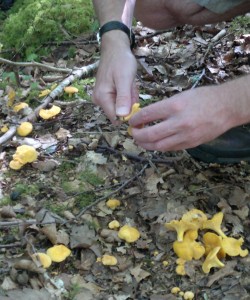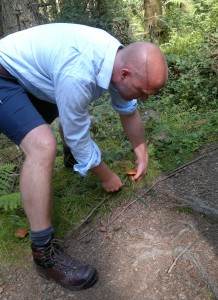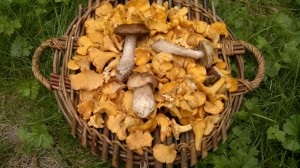How to harvest wild mushrooms – Cutting v Picking
There are two schools of thought among foragers on the best way to actually “pick” a mushroom. One asserts that fruit bodies should be cut off where they join the ground (or whatever they are growing from) so as not to damage the delicate mycelium below. The other prefers to twist and pull the mushroom from the mycelium. I have heard it argued that this stops the residual stump left by cutting from rotting and “infecting” the mycelium. This is clearly ridiculous as all fungi will rot away eventually if left to their own devices.
Related Posts:
- Chanterelles – Edibility, Distribution, Identification, Ecology
- An Introduction to Fungi Foraging
- Responsible Foraging
- Legal Foraging
- Foraging, Sustainability and the Media
- Foraging In The Modern World: Eating Nature
- Fungi Knives – The Lowdown

Chanterelles happily and cleanly detach from their mycellium. You then only need to snip off the dirty bit of base and give them a quick brush down and they are ready to cook when you get home
I have seen very heated exchanges between the two schools over whose technique is more ecologically sound.
The truth is that it makes very little difference to the fungus either way, in the same way that it makes little difference to an apple tree whether you cut or pick its apples.
The most important ecological consideration is that the fungi has been allowed to mature to a point where it has distributed most of its spores.
A forager is more likely to damage mycelium by compacting or disturbing ground or leaf litter with their feet than by any picking technique.
Check out the long-term studies linked in this article, that conclude that that it makes next to no difference – in the species studied (mostly chanterelles). I use italics for this because, as is so often the case, the more you look, the more you see there is to see!
Practical experience shows that mycorrhizal fungi (those living in complex symbiosis with vascular plants, eg. chanterelle, cep, hedgehog mushroom) almost always detach cleanly when pulled from their mycelial web, while saprophytic fungi (those rotting down fallen vegetative matter. e.g. wood blewit, clouded agaric, shaggy parasol etc) tend to bring a large clod of mycelium, and plenty of whatever it was feasting on, with them when pulled. So I tend to apply different rules to different species.
On the whole, I generally use the cutting method when picking easily identified species as it minimises disturbance. The accurate identification of some species (notably of the Amanita genus), however, can rely on minute identification features at and just below ground level. In these instances it can be necessary to uproot the entire specimen before covering up the exposed mycelium to keep it from drying out.
Read about the nuances, science and ethics of chanterelle harvesting here
I generally advocate the following guidelines:
1. Don’t pick chanterelles, hedgehog mushrooms, winter chanterelles and other small mushrooms that have a cap diameter less than 2cm. Similarly, ensure boletes, russulas, horse mushrooms, parasols and other larger mushrooms have caps larger than 4cm diameter. These sizes are legal requirements for selling mushrooms on the continent, but are sadly not enforced in the UK.
2. When you are picking a patch of fungi, try to leave the smallest 50%, regardless of size.
3. Where mushrooms are growing in pairs (commonly chanterelles), only pick one.
4. Collect mushrooms into a basket or porous cloth bag that will allow spores to disperse as you move – not a plastic bag. Place the mushrooms in the basket with their gill/pores facing down.
5. Try to identify mushrooms without picking them. Often accurate identification requires close examination from all angles, but I often see people picking before they engage their brain, needlessly uprooting inedible mushrooms.
6. Dipose of mushroom trimmings and waste in a similar habitat to the one you picked it in.Its best to trim and clean them in situ, which also means dirt and debris doesn’t get lodged in gills or pores, making them much harder to clean when you get them home.
With a few exceptions for highly invasive species such as honey fungus, these rules help support mycological diversity. Fungi perform a crucial job, breaking down debris, nurturing trees and building soils, as well as being a valuable food and home for insects. Following these rules will allow you to harvest on a regular basis with a happy heart and a clear conscience.
Related Posts:


18 Comments
thank you, very informative. if you have not read “the mushroom hunters” by Langdon cook, you should! it was a fascinating book about the picking culture and joys of mushrooms
Hi Brooks,
Yes, I have read The Mushroom Hunters – a great read and reminded me of my days as a full-time harvester.
Hi everyone,
Let me enlighten you about a 35 year study from Germany on how to harvest mushrooms.
In plain and simple english, it doesn’t matter (exception is the chaga).
They have done trials over a 35 year period and proven that it is irrelevant if you cut or pull out the mushroom, if you compact the soil by walking on it, or not walking on it, it purely doesn’t matter.
What matters to the fungi is the influence of the weather and environment.
Also it was said in the above article to leave the young ones, it really should say leave the older ones, as they have a better chancs to spore, the chance of younger ones to be eaten is far greater.
Happy hunting
Thanks Udo. A link to this study would be useful? As always with fungi, trying to come up with one rule on harvesting to apply 7000+ species isn’t very useful IMO. We wouldn’t do that with plant harvesting techniques, so why do so many people wish to apply “one size fits all” rules to fungi harvesting? What works for rapidly growing species such as ceps, may not work for slower growing species like, say, hedgehog mushrooms. See 2.3 here: http://www.foragers-association.org.uk/index.php/principles-and-practice
http://fungiflora.com/2016/08/25/how-to-pick-mushrooms-correctly/
has references to studies “cutting vs picking” — enjoy!
Thanks Paul – I’ve discussed these studies (and a few more) in this article:
Picking apples isn’t a great example of method not mattering. Pick wrong (pull up and toward the center of the tree) and you’re likely to pull off the twig it’s attached to, removing the fruiting bud and reducing future fruit yield. Twisting while you pull down and away is much less likely to damage the bud. Don’t know a thing about mushrooms though.
Excellent point!! Thank you.
I was taught to cut most of the mushrooms I hunt and have had people go off on me about how there is no difference between pulling and cutting and there is 20 plus years of research to back it up I don’t see how when all mushrooms are not the same and I still think that it is better to cut it makes less prep work. And what about raking truffles because I do so and don’t use a dog apparently makes me a monster.
I’m curious which studies your recommendations are based on? It looks like a lot of mushroom picking guides are based on plant harvesting guidelines, which simply don’t apply to mushrooms as mushrooms have a very different life and thus different needs. The statement by the foragers association you linked to does not distinguish between mushrooms, plants or animal harvests, which I believe is problematic
These recommendations are based on Scottish Natural Heritage, Scottish Fungi (Website) and the Scottish Wild Harvest Association’s advice in the Scottish Wild Mushroom Code, plus 30 years experience and working with mycologists and conservation organisations. The Association of Foragers statement of Principles and Practice does not claim to be a “mushroom picking code”, but a list of general principles applicable to all types of foraging in a general, but not specific sense. http://www.forestharvest.org.uk/guidelines/Mushcode.htm
I have a decent size patch of st george mushrooms in my garden which have only appeared this year. I was a bit cagey about them but now sure they are edible. I left them in my garden, am i better picking them or leaving them to encourage for next year.
It has been a bumper year for St George’s mushrooms in many areas of the UK, so perhaps you have noticed them because this year there are lots, while usually there are just a few. Carefully gathering the mature, fully opened mushrooms, while taking care not to trample the mycelium in the top layer of soil, will do no harm at all. In fact, if you carry them with the gills down, in an open-weave basket, you will likely be doing the fungi a favour by helping to broadcast its spores over a wider area. Enjoy!
Mark.
I want to know in the time of plucking the mashrooms what problmes arise? And if we don’t plucked a mashrooms at right time then which kind of problems arise
I think the key point is that we ensure any mushroom we pick has reached a point at which it has dropped a significant proportion of its spores. There is large variation between species – as discussed here: https://gallowaywildfoods.com/chanterelles-sustainable-and-considerate-harvesting/
Thank you very much for all this knowledge! I very much agree about the importance of maturity and using baskets it is so important, to carry the spores through the forest! As the mushrooms need the wind, they also need us to spread their spores and we need them as food!
Are there a rule of thumb, that states mushroom species should be kept separated while harvesting? Can I mix them in my bag?
No rules – just common sense….if you are picking mushrooms you know to be edible, there is no issue around mixing them other than having to sort them out again if you want to do different things with different species. If you are picking edible mushroom AND unidentified/inedible mushrooms to examine at home, its sensible to have a separate container for them to avoid cross-contamination. I carry a couple of small plastic tubs with lids in my basket for this purpose.
Mark
1 Trackback